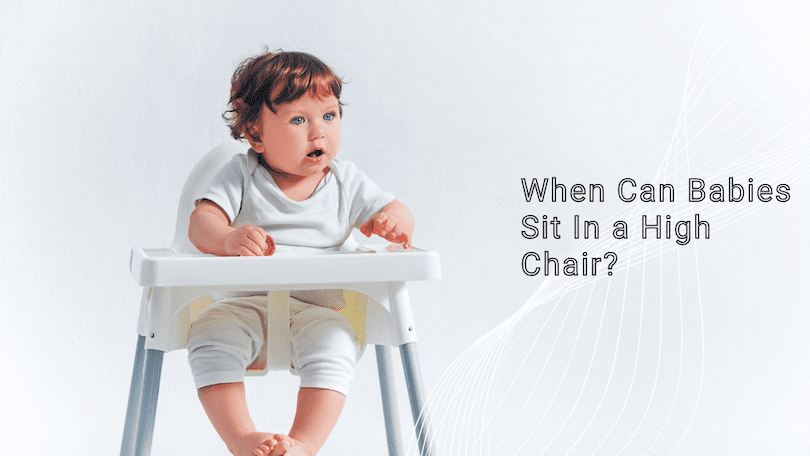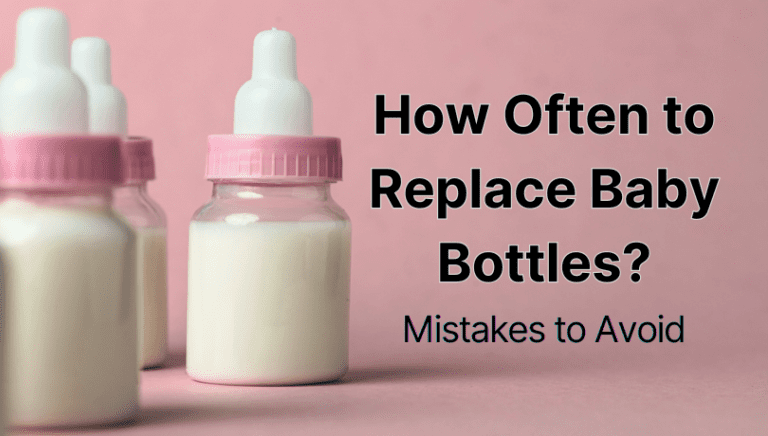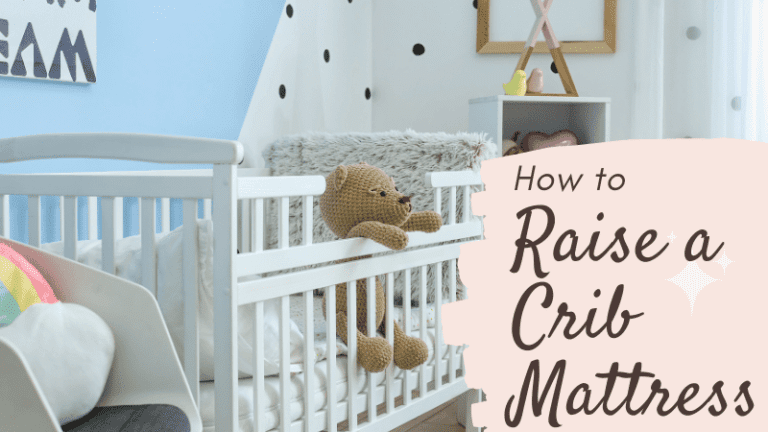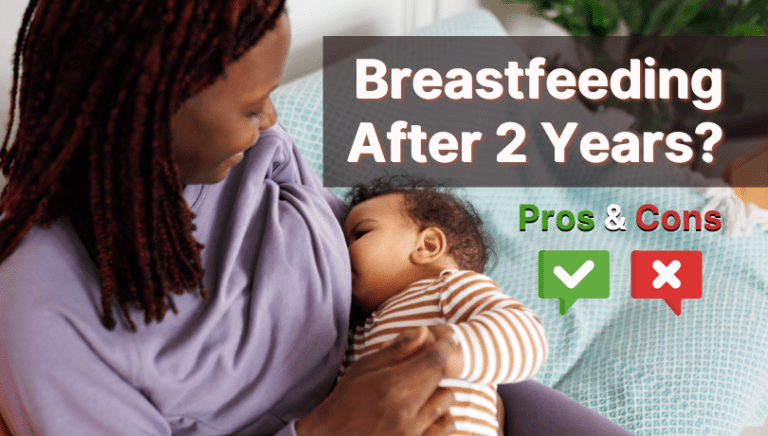When Can Babies Sit In a High Chair: A Comprehensive Guide
Parents know how MESSY a baby’s mealtime can be! High chairs help you to make the mealtime easier. Studies say the right time to use high chairs is when a baby starts to hold its head steadily, ready to eat solids (+6 months of age), and sits firmly when supported. You must let your baby take its time to adapt to this transition from your lap to a chair.
Many new moms may not be aware of introducing and using high chairs properly for their babies. Not to worry! I’m Kelleigh, and I’m here to help you!
I have created this article to know when babies can sit in a high chair. We’ll also cover its advantages, what precautions you should take while doing this, etc. So, let us move ahead and learn more about this.
Table of Contents

When Can Babies Sit In a High Chair?
My cousin, Sammy, had a baby boy a few months back. He gained his head control when he turned 4.5 months old. One day she asked me, ‘Hey Kelleigh, is my baby ready to sit in a high chair? I want to start feeding him solid as he will turn 6 months soon. How will I know that this is the right time?’
The answer to this question is simple: You should start using a high chair when your baby:
- Can sit upright with minimal support
- Gains optimum head control
- Has an age of 4 to 6 months and above
You can also use reclining high chairs at first. You can adjust the reclining seat as per your baby’s comfort in these chairs. These chairs are safe for babies above 4 months, as at this age they start showing some developmental signs, such as:
- Showing interest in grabbing and handling utensils, food, etc., on their own,
- Showing curiosity for holding and eating different kinds of food for self-feeding.
- Exploring the texture and taste of things via touching, biting, licking, etc.
- Some babies start teething from 6 months onwards. Using a high chair to introduce various kinds of food is a good choice to calm their developing gums.
Why Should You Use a High Chair For Your Baby?
Some parents want to wean off breastfeeding, or some would like to introduce babies to semisolid foods at this age. If you are a mom, you may understand what I am talking about!😃
So, let us read the pros of using a high chair for babies.
6 Advantages Of Using A High Chair:
- Babies build a sense of independence for eating food on their own. This is the first step to FREEDOM for them, right?
- Reclining high chairs support the baby’s neck, head, and spine. Parents switch to the upright sitting when the baby gains proper control of these body parts (usually 6 months+). Such chairs allow smooth swallowing and less choking of food bites.
- They build communication skills, develop language skills, and learn to follow instructions for table manners.
For example, I used to make all my children sit at the table for dinner. Little Theo (my youngest child) used to see us praying to God before eating. Soon, he adapted this routine and started making the hand gesture of praying before food.
- Slowly, they learn how to eat at a table. Babies are still in the learning phase to handle things! They will throw food more at 6 months of age. (Yes, there will be a mess at first. Be ready for that!🙂) But, eventually, they learn how to sit properly, put utensils in the right place, and eat calmly.
- They build bonding with family members and social interactions while eating. A happy mealtime is equal to a happy baby!
- High chairs give them a sense of safety. Tugging your baby in a safety harness makes them aware of safe play with bowls and spoons, and secure mealtime.
How to Use a High Chair Safely? 10 Main Safety Checks
- Check if the chair is in good working order before using it. Return or replace it if damaged.
- Make sure your baby is strapped securely in the safety harness. There should not be any slack or void in the straps to avoid slipping hazards. Use chairs with 5-point-harness.
- Use a seat insert if your baby is smaller for the chair seat.
- Keep your baby always in your view. Never leave your baby alone unattended in a high chair.
- Read the instructions manual before assembling and using the high chair.
- Many babies develop a habit of chewing due to the teething phase at 6 months and above. They may chew the sidearms of the chair, spoons, glass, etc. Make sure the material used in the chair is toxin-free.
- Babies tend to kick their feet. Keep the chair away from flat surfaces like a wall. This avoids chances of falling even if the baby kicks.
- Check for warning labels from the manufacturer to avoid possible risks. Such labels are usually stitched at the side of the seat or on the straps.
- The CPSC advises choosing high chairs with a fixed crotch post attached to the tray or seat. This avoids the child from slipping from the seat area.
- Follow 90-90-90 Rule:

If your baby is above 6 or 7 months, ensure it sits in the ‘90-90-90’ position in a high chair.
The angle between the ankle, knees, and hips must be 90 degrees.
This ensures safe food swallowing.
Expert Tips To Choose A Baby High Chair:
I attended a parenting group called ‘Mom Tribe’. They used to invite doctors and experts to make new moms aware of safe parenting. Once, Dr. Nina, a renowned pediatrician in our locality, came to guide us about using high chairs. That session helped me understand important things while using this baby essential.
There is no perfect parenting formula. You must understand the core parenting fundamentals and sense your gut feeling to do what’s right for your child!
Likewise, from my gathered knowledge and motherhood experience, here are key takeaways to select a high chair for your baby:
1. Durability
The seat, strap, footrest, and tray should not be damaged. The chair’s legs should be strong enough to hold the growing child’s weight. Nowadays, some high chairs can hold up to 300–350 lbs. Hence, a kid can use such chairs until 10–15 years of age; or, an adult can sit in such chairs too. For example, Stokee Trip Trapp Chair can take up to 300 lbs weight. Make sure that it’s built to last.
2. Sturdiness
The chair’s legs should not wobble after you put a baby in it. Babies tend to move more and wiggle all the time. The chair’s base should be sturdy enough to keep the body stable. It should not easily tip over on kicking.
3. Design
The high chair’s design should be sleek and elegant. E.g. Too much printed seat may distract the child from eating. Ensure the seat is comfy, the side edges are smooth, and the overall color is calming.
4. Easy To Clean
Kids tend to spill food and liquids on a chair while eating. Hence, the chair gets stained or soiled. The tray should be easy to detach and clean after wiping. Some high chairs come with a high-quality dishwasher safe tray for easy cleaning. Also, the seat covers should be removable and washable. The chair should have minimal areas/ gaps where food particles and liquid drops can entrap.
5. Portability and Foldability
The chair should be lightweight to lift and easily movable. This helps to bring the chair easily from one home to another place while travelling. It must have locking wheels at the base. It helps to move the baby in the chair from one room to another.
Foldable chairs are space-saving and easily get stored in compact spaces like cabinets, car trunks, etc.
6. Footrest
The footrest assures your baby’s legs get proper base support. It avoids the excess sensory stimulation for the baby’s legs from kicking. It also assures a 90-degree angle while sitting.
7. Height Adjustment
A growing baby needs more space to adjust its legs while sitting in a high chair. Height adjustable chairs ensure your baby sits comfortably in the chair without strain on their ankles.
8. Price
The price you are investing should justify the features you are getting in the high chair. Buying a luxurious branded chair with fewer features makes no sense. Many budget-friendly chairs are available in the market, which give maximum safety and features to fulfil your baby’s mealtime needs.
9. Versatility Of Use
A baby uses a high chair for eating meals for at least 2 years. Later on, as the baby grows, the same chair can be used as a desk for studying or completing any activity. For this, you can get the chair that grows with your child! The tray side locks and the legs’ height should be adjustable to meet these needs. Such chairs are useful for older children too (14–15 years).
I bought the Abiie Beyond Junior High Chair for Theo. Sometimes Sawyer uses it to complete her assignments. We also sit on it to read a book.
Secret Tip: Check if the high chair model or features you are choosing are in the ‘Recalls’ of the Consumer Product Safety Commission CPSC to avoid future falling or slipping hazards.
How To Make Your Baby Sit on a High Chair? Tips From Mommy Of 6!
My first child, Avery, started to sit happily in her Graco high chair when she was 4 months old. It was like her own little throne! 😄
But, my fifth child, Sawyer, threw many tantrums while sitting on the high chair. I wanted to introduce semi-solids to Sawyer. I used to sing melodies, give plates and spoons to her for playing, or narrate stories so she could sit steadily to eat food. Finally, at 7 months of age, she started sitting in that chair for a longer time. I realized that using a high chair for Avery introduced her to a sense of independence. For Sawyer, it built her confidence for adapting to new environments.
Many parents come across such situations, right?
That’s why I am sharing these pro tips to make your baby ready to sit in a high chair:
1. Go Slow:
Sitting in a high chair is a new sensory stimulation for babies. Some may like it, some may not. That’s why, keep the sitting time shorter for the first few days (like 5 mins approx.). Help your baby to get introduced to mealtime in the chair. Start with small food portions initially. You can increase the food portion as the baby grows and learns to eat properly.
2. Gradually Increase Sitting Time:
Once your baby gets settled in the chair for a few minutes, gradually increase the sitting time.
3. Have a Playtime or Story time:
Your baby may become fussy or cry out loud initially. To soothe your baby, tell them a story while feeding them food. Or, give them an empty bowl or spoon before food.
Pro Tip: Let them make a mess, chew spoons or trays, kick the footrest, or throw food. I know it takes time to clean. Studies strongly suggest that babies develop their sensory stimulation while doing this.
Frequently Asked Questions
When to stop using a high chair?
You can stop using a high chair when your baby outgrows the seat capacity of the high chair(3-4 years of age). Or, you can stop using this chair when your baby shows more interest in eating with everyone at the table with proper spine and head support.
Is my 4-year-old too old for a high chair?
Normal high chairs are designed for babies between 1 and 3 years. Your 4-year-old child can still sit in the high chair to eat meals or read books. It all depends on your baby’s preferences and chair capacity. Some high chairs are designed for kids to use till their teenage years too.
What is the alternative to a high chair?
Booster seats are a great alternative to high chairs. They are useful when you want your child to eat at the table with everyone. These seats are space saving, easy to store, and portable.
Conclusion
Using a high chair at the right time is not as overwhelming as it looks. You can start using it as your baby turns 4 months old. Some brands even suggest using it for newborns, using seat inserts for proper support. In my opinion, you should continually look for your baby’s cues, try different methods to make the baby sit in the chair.
Let the baby explore the high chair at its own pace and comfort. Keep your baby safe from potential high chair hazards like slipping, choking, rolling, pinching fingers in gaps, or tipping over. If you follow proper routine and discipline, your little one will eventually prefer to sit in the chair only for eating food!
It all depends on what mealtime practice you follow and what your parenting instincts say! Whether it is ‘Baby Led Weaning (BLW)’ or engaging mealtime, a high chair will always help! I hope this article has helped you to understand, ‘when babies can sit in a high chair?’. If you have any questions, feel free to ask me on my email. I am your parenthood bestie who is always there to help you!






